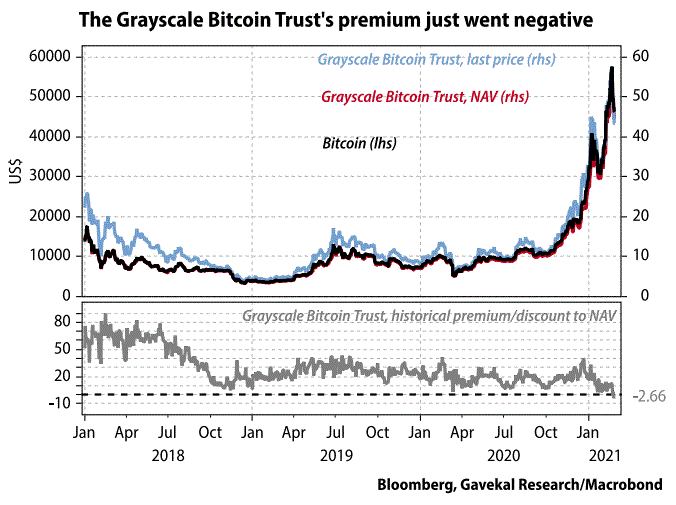Louis-Vincent Gave at GaveKal:
There are two kinds of bubbles: bubbles in productive assets like railways, and broadband lines, and bubbles in scarcity assets like tulips and gold. In turn, these bubbles can be funded through equity, or by debt. The best kind of bubble is in productive assets, funded by equity and the worst kind is in unproductive assets, funded by debt, especially if the leverage is hidden.
In 2008, total sub-prime mortgage loan losses were estimated by the OECD at about US$350bn. That was not a huge number but when losses began to emerge, investors discovered that Bear Stearns, Lehman Brothers and others were all running debt levels of 40 times their equity, or more. Confidence was shaken and the financial architecture at the heart of our economies froze. In time, multiples of that US$350bn had to be spent by the US, China, the UK, Japan, France and others to ensure their economies’ survived.
Why return to this painful past? Because as the market value of bitcoin exceeds US$1trn, investors are increasingly left with a quandary. After all, in the coming year, one of three things could occur:
1) In defiance of its historical record, bitcoin broadly flatlines, inflicting neither losses, nor gains, on its holders.
2) Bitcoin continues to power ahead and starts to challenge established currencies in earnest. Cue a continued bond market meltdown.
3) Bitcoin crashes by more than -50%, as it has done before. The big difference this time around is that losses of US$500bn would be consequential.
So should we worry about potential big nominal losses in the crypto-currency markets? A few weeks ago I would have said that a hypothetical US$500bn in bitcoin losses would prove insignificant relative to US$350bn in subprime losses for a number of reasons, namely, (i) such a fall would bring the price of bitcoin back to where it stood at the end of 2020, (ii) bitcoins are held by a limited number of people (thus a fall in their price should not impact overall consumption) and (iii) the price of bitcoins is not a factor in most firms’ capital spending plans. Most importantly, I would have said that a big fall in the bitcoin price would be sucked up because no-one would be crazy enough to buy them with large amounts of debt. In my mind, bitcoin was thus a “good bubble” in that it did not have leverage.
But having read Kevin Muir’s latest must-read newsletter, my “no leverage” conviction is dimmed. This has nothing to do with firms like MicroStrategy issuing convertible bonds to buy more bitcoins but is due to the arbitrage strategies used by hedge funds and other institutions to get access to bitcoin.
For most institutions, the real challenge of investing in bitcoins is the chain of custody. Funds typically need a State Street or a JP Morgan to sign off on the assets they claim to have on their books. This is easy for stocks, bonds or even commodity contracts. It is far more challenging for crypto assets.
But then Wall Street is always happy to rise to a money-making challenge.
Cue the creation of the Grayscale Bitcoin Trust (which only holds bitcoins) and its impressive growth to US$30bn market capitalization. Behind this growth lies an enthusiasm for crypto-currencies but also the opportunity of an attractive arbitrage. In recent years, Grayscale has benefited from being Wall Street’s main bitcoin dealer and its shares have thus commanded an average premium of 27% to the price of bitcoin. That premium was always likely to attract the attention of arbitrageurs.
The way it works is that institutional investors can get new Grayscale shares issued more or less at their net asset value, with the important restriction that new shares have a six month holding period. Thus, for the past few years, one could spend US$1 for an asset that would, on average, be worth US$1.27 six months later. What’s not to like with that return profile? And given that it works so well, why not do it with leverage? What could go wrong?
Well, that 27% average premium of Grayscale shares could always disappear perhaps because too many people get involved, or other vehicles are set up.
Then, like most other closed-end funds, it could begin to trade at a discount to its net asset value. And in fact this is just what happened to Grayscale investors late last week (see chart on previous page), meaning that players who put the trade on with leverage in the last six months will likely be facing margin calls, which is seldom a positive development for markets.
On this point, my friend Kevin Muir, compared a possible macro-level problem in the crypto markets with the 2008 sub-prime crisis: “The next crisis will occur in an asset that regulators don’t understand. It will be an asset where they aren’t aware of the amount of leverage being employed. It will be something viewed as a ‘can’t lose’ situation by market participants (much like housing in the early 2000s), and something outside traditional capital restrictions (much like CDOs and other off-balance sheet items).”
Such a notion brings me back to the idea that Kryptonite for investors is an unproductive bubble funded with hidden leverage. It will be interesting to see if bitcoin fits that bill; and, if so, whether Grayscale’s decline proves to be the “Countrywide moment”?


